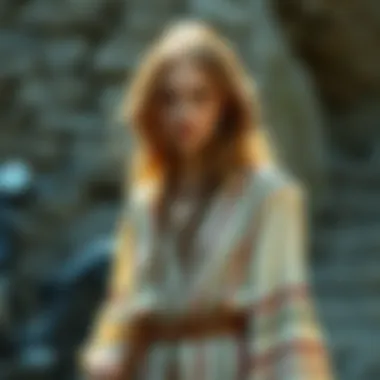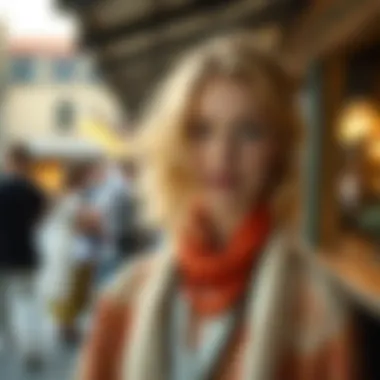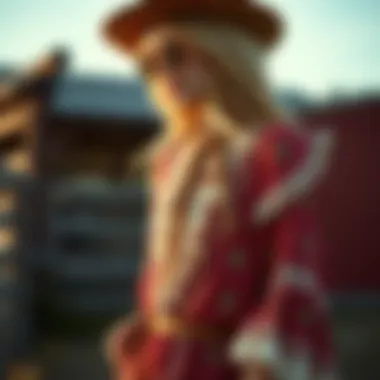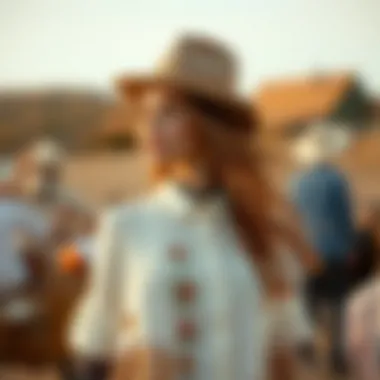Exploring Bohemian Designer Clothes: A Comprehensive Guide


Intro
The realm of bohemian designer clothes stands as a vibrant tapestry of culture, history, and personal expression. It’s not mere clothing, but rather a lifestyle that resonates deeply with individuality and creativity. To delve into this world is to uncover layers of artistic influences that date back to the 19th century and beyond. As we explore this topic, we will touch on various facets — from historical roots that shaped the bohemian style to the modern interpretations that dominate today’s fashion landscape.
One cannot overlook the sustainable practices that have made their way into this genre of design. As today’s fashion enthusiasts become increasingly aware of their environmental footprint, bohemian styles, with their focus on natural materials and craftsmanship, are gaining traction. Thus, understanding the significance of these practices in combination with the artistry behind bohemian designer clothes offers invaluable insight for fashion designers, stylists, and enthusiasts alike.
As we dive deeper, we will explore styling tips that dovetail personal flair with bohemian influences, allowing wearers to express themselves fully through their choices. Additionally, by offering precise fabric care tips, we aim to extend the life of these cherished garments, ensuring they remain staples in wardrobes for years to come.
This comprehensive guide aims to enlighten those who wish to embrace the essence of bohemian design while navigating the latest trends and techniques. Embrace the journey as we unfold the vibrant and diverse world of bohemian fashion.
Understanding Bohemian Fashion
Understanding the essence of Bohemian fashion is crucial for anyone interested in the world of designer clothes. This style, rooted in a rich tapestry of history and culture, offers insight into the individuality and creative expression of its wearers. Bohemian clothing transcends mainstream trends, allowing for a celebration of personal aesthetics and freedom of style. Each piece tells a story, blending elements from different cultures and eras, creating an eclectic harmony.
Origins of Bohemian Style
Historical context and influences
The origins of Bohemian style can be traced back to the nomadic Romani people in the 19th century, who were often viewed as outsiders in European society. Their unique dress, characterized by flowing silhouettes and vibrant patterns, influenced artists, writers, and musicians of the time. This movement attracted those who sought to rebel against societal norms and conventions.
The artistic circles of Paris in the late 1800s amplified this influence, with figures like Henri de Toulouse-Lautrec and others adopting these styles, marking a notable shift in fashion towards comfort and individualism. The key characteristic of this historical context is its deep-rooted sense of defiance against the conventional lifestyle, which resonates even today.
This aspect of Bohemian style is beneficial in the sense that it inspires creativity and encourages people to express their identity. The unique feature of this history is the constant evolution, where every decade builds upon the previous one, integrating modern interpretations. However, it also raises questions on authenticity—how to honor roots while adapting to contemporary fashion.
Socio-cultural implications
The socio-cultural implications of Bohemian fashion reveal a lot about human expression. This style has often been linked to movements advocating for social change, freedom, and anti-establishment sentiments. It’s more than just clothing; it’s a statement. The combination of affordability, accessibility, and eclecticism provides a voice for those who might feel invisible in a fast-fashion world.
The central feature here is the celebration of diversity and inclusivity, which has become critical in today’s global landscape. By embracing various cultural aesthetics, Bohemian fashion fosters an environment of acceptance. However, it does come with caveats; cultural appropriation remains a sensitive topic—how to appreciate without taking, and this balance is often challenged within the fashion industry.
Evolution through the ages
The evolution of Bohemian fashion highlights its adaptability and resilience. From the Victorian-era adaptations to the hippie movement of the 1960s and 70s, Bohemian fashion has transformed while retaining its core principles. Each era sheds light on societal changes, protests, and artistic revolutions.
As trends come and go, one key characteristic is the emergence of new subcultures that redefine what Bohemian means. For instance, the rise of eco-conscious fashion has injected new life into the movement, with sustainable practices blending seamlessly into the Bohemian ethos. This evolution is advantageous as it keeps the style relevant, ensuring that it caters to current values like sustainability and ethical consumerism.
Nonetheless, the unique feature of its evolution is the risk of dilution. As it becomes mainstream, the authenticity of the original ideals may be compromised, complicating the definition of what constitutes true Bohemian fashion.
Defining Characteristics of Bohemian Designer Clothes
Key design elements
When it comes to Bohemian designer clothes, key design elements play a pivotal role in defining this style. These garments often feature relaxed silhouettes, draping fabrics, and intricate detailing. Layers are common, allowing individuals to create a unique look that feels personal and comfortable.
This inherent quality of self-expression is a highly beneficial aspect, inviting wearers to mix and match according to their mood. The diverse elements include everything from lace to crochet, all contributing to the overall Bohemian aesthetic. However, the challenge lies in ensuring that eclecticism doesn’t veer into chaos; maintaining coherence while layering various styles is essential.
Color palettes and patterns
Bohemian design frequently embraces a broad spectrum of colors and patterns, ranging from earthy tones to vibrant hues. The use of intricate prints, often inspired by nature, creates an organic feel. Florals, paisleys, and geometric shapes are staples in the Bohemian wardrobe.
The emphasis on color signifies freedom, embodying a spirit that encourages joyful experimentation. This diversity in patterns allows individuals to make bold statements. Yet, there's a potential downside; too much variety can muddle an outfit, leading to confusion in style. The art is in balancing vibrancy with subtler tones.
Preferred fabrics and textures
Bohemian designer clothes owe much of their charm to the use of natural fibers and textured fabrics. Cotton, linen, and silk are favorites, offering breathability and comfort. These materials also align with eco-conscious practices that many modern designers adhere to, which adds a layer of sustainability to the Bohemian ethos.
What makes these fabric choices significant is their longevity and comfort. The skin-loving qualities of these materials ensure both fashion and function. However, the downside could be the price point; high-quality natural fabrics can be costly, which may limit accessibility for some consumers. Ensuring a balance between cost and quality is vital for those who wish to embrace the Bohemian lifestyle.
Sustainability in Bohemian Fashion
In the world of fashion, the conversation around sustainability has become not just relevant but essential. For bohemian fashion, which thrives on an ethos of creativity and individual expression, the intersection of sustainable practices with style presents a unique opportunity. The focus on sustainability in bohemian fashion goes beyond mere aesthetics; it intertwines with the core values of the bohemian lifestyle. Here, we explore ethical sourcing, upcycling, and the impact of vintage choices, bringing to light how these elements shape a more conscious approach to fashion.
Ethical Sourcing and Production


Impact on Local Communities
Sustainable fashion isn't just a trend—it's a lifeline for many. The impact on local communities plays a critical role in shaping the ethical landscape of bohemian designer clothes. Many brands focus on sourcing materials from local artisans, ensuring economic support to those communities. This not only boosts local economies, but fosters a sense of heritage and craft that elevates the design itself.
However, there are challenges. Always sourcing ethically can be an uphill battle due to globalization, where cheaper production costs often overshadow local benefits. But choosing brands that emphasize local craftsmanship means supporting a unique culture and its stories.
Material Transparency and Responsibility
Material transparency and responsibility is gaining traction in the bohemian scene. Customers nowadays are educated and demand to know where their clothes come from and what they're made of. Brands that provide clear information about their materials establish trust with their consumers—this is paramount. It reflects a commitment to accountability, ensuring that the materials don't just fulfill style criteria, but are also ethically produced.
The downside? Full transparency can sometimes come with a higher price tag, which may discourage some buyers. Yet, the trade-off is often worth it when considering the values supported by informed purchasing decisions.
Examples of Sustainable Brands
When it comes to examples of sustainable brands, the fashion realm offers several noteworthy names. Brands like Reformation and People Tree stand out for their dedication to minimizing their environmental footprint while still appealing to the bohemian aesthetic.
These companies illustrate that sustainable fashion doesn't have to sacrifice style for ethical considerations, showing that consumers can have their cake and eat it too. Yet, it's essential to remain vigilant; not all brands that claim to be sustainable deliver on those promises. Scrutinizing their practices can mean the difference between making a conscientious choice and falling for greenwashing.
The Role of Upcycling and Vintage
Benefits of Upcycled Fashion
In the pursuit of sustainability, upcycled fashion has come to the forefront. Upcycling involves taking old or discarded clothing and transforming it into something new, thus reducing waste. The benefits of upcycled fashion lie not only in saving the planet but also in fostering originality. Each piece tells a story and often reveals a unique artistry that factory-produced garments can't replicate.
However, while upcycling offers a sustainable option, the availability of suitable materials can sometimes be limiting. It takes creativity and a keen eye to find pieces that can be successfully upcycled—this might be a barrier for some fashion enthusiasts.
Mixing Vintage with Modern Pieces
A hallmark of bohemian style is the ability to mix vintage with modern pieces. This blend allows individuals to create layered looks filled with personality. Integrating vintage items into contemporary outfits can result in a fresh approach to dressing, embracing history while setting trends.
This style-choice can resonate strongly, reflecting a respect for fashion's roots. However, it can be challenging to source genuine vintage items that align with modern sensibilities, especially for those new to the vintage scene.
Tips for Sourcing Second-Hand Bohemian Clothes
When it comes to sourcing second-hand bohemian clothes, there are several strategies one can employ.
- Start at local thrift stores or flea markets; these often contain hidden gems.
- Use online platforms like Depop and Poshmark, which specialize in second-hand fashion.
- Engage with local fashion communities through social media for trade events and swaps.
These approaches can help reduce the carbon footprint while filling wardrobes with unique items. Still, one must be cautious. Sometimes the condition of second-hand items may not meet expectations, which is why a careful eye and a little patience go a long way.
Key Materials in Bohemian Designer Clothes
In the world of bohemian fashion, materials play a pivotal role in defining both style and sustainability. Key materials are chosen not just for their aesthetic appeal but also for their comfort, environmental impact, and cultural significance. Understanding these materials allows designers and consumers to make informed decisions that honor the bohemian spirit while promoting responsible fashion practices.
Natural Fibers and Their Importance
Cotton, linen, and hemp
Cotton, linen, and hemp stand out as the cornerstone natural fibers in bohemian design. These materials are breathable and lightweight—traits that make them ideal for creating flowy garments that embody the essence of bohemian fashion. Cotton, soft and versatile, fits a range of styles but has an important ecological footprint, depending on its production methods. Linen, derived from the flax plant, holds a luxurious yet relaxed vibe. It's naturally hypoallergenic and becomes softer with each wash, which is a massive plus for comfort seekers. Hemp, often touted for its long-lasting nature, is gaining popularity for its minimal environmental footprint. Its ability to thrive without pesticides makes it a prime candidate for eco-conscious designs. All in all, these fabrics contribute to sustainable practices in fashion, aligning perfectly with the bohemian ethos, which celebrates individuality and nature.
"The choice of fabric can either uplift or undermine the entire aesthetic of bohemian clothes."
Eco-friendly dyeing processes
Eco-friendly dyeing processes are fundamental in ensuring that the vibrant colors in bohemian fashion remain sustainable. Traditional dyeing methods can wreak havoc on local water sources, while modern eco-friendly alternatives harness natural pigments from plants and minerals. These processes often utilize less water and reduce harmful chemical usage. Notably, innovations like waterless dyeing are revolutionizing production methods by conserving resources and minimizing ecological damage. Eco-friendly dyes not only contribute to sustainable fashion but enhance the appeal of bohemian wear, as they tend to produce softer, more complex colors that resonate with the earthy tones often found in this style.
Impact on comfort and wearability
The impact of chosen materials on comfort and wearability cannot be overstated in bohemian design. Natural fibers like cotton, linen, and hemp have inherent properties that make them breathable, allowing air circulation that’s essential in warmer climates. Moreover, their ability to absorb moisture provides a comfortable fit that doesn't cling or irritate the skin, a significant consideration for individuals leading active lifestyles. Additionally, the ongoing use of soft finishes and natural textures enhances how these garments feel against the body. When selecting bohemian clothing, comfort should work hand in hand with aesthetic value, as the true essence of bohemian fashion lies in its free-spirited, easy-going nature.
The Use of Embroidery and Textiles
Traditional techniques and modern adaptations


Embroidery serves as a bridge between tradition and modern fashion in the realm of bohemian clothing. Many cultures have rich histories of handcrafted embroidery, which imbue garments with stories and significance. By adapting these age-old techniques, contemporary designers can infuse originality into their collections. This fusion not only retains cultural heritage but also lends a unique aesthetic that appeals to a wider audience. The handwork involved often supports local artisans, ensuring that communities benefit economically while preserving their craft.
The aesthetics of embellishment
The aesthetics of embellishment in bohemian clothes often play a major role in defining the overall look. From intricate beadwork to layered textiles, embellishments add depth and richness to outfits. The beauty of bohemian style lies in its chaotic harmony—different textures, patterns, and colors come together to create an eye-catching visual. This multitude of embellishment options allows for personal expression, inviting wearers to curate their own unique style while embracing the eclectic nature of bohemian fashion.
Balancing visual appeal with functionality
Balancing visual appeal with functionality can be a tricky dance in the world of bohemian fashion. Designers strive to create clothes that not only look good but also fit into the wearer's lifestyle. Bohemian designs often feature adjustable elements, like drawstrings and layers, that can be modified for comfort without sacrificing style. Moreover, considering the practical aspects like pockets and overall fit enables a savvy approach to bohemian fashion. In doing so, individuals can cultivate their personal style without compromising on usability, making these garments a practiced choice for both everyday wear and special occasions.
Styling Bohemian Designer Clothes
Styling bohemian designer clothes holds immense significance in understanding the unique flair and ethos of this fashion genre. The essence of bohemian aesthetics is deeply rooted in freedom of expression and an individualistic approach to style. This pivotal role comes into sharp focus when one considers how bohemian clothing can be styled to reflect both personality and environment. Unique combinations of fabrics, colors, and silhouettes exemplify the spirit of creativity and non-conformity inherent in bohemian fashion. This versatility also serves practical purposes, catering to various occasions and the wearer’s personal taste.
Layering Techniques
Layering techniques are a cornerstone of bohemian styling, enabling wearers to mix and match pieces to convey diverse looks. This allows for personal creativity while adapting to varying temperatures and settings.
Maximizing versatility
Maximizing versatility refers to the concept of creating multiple looks from a limited wardrobe by cleverly layering clothing. This approach encourages a sustainable fashion mindset, allowing one to express creativity without overindulging in consumption. A hallmark feature of versatility is the ability to transition from day to night effortlessly. For example, a long, flowy kimono can be paired with jeans for casual coffee runs, and later matched with heeled boots for an evening out. The main advantage here is functional adaptability, making it a favored tactic among bohemian enthusiasts.
Creating depth and dimension
Creating depth and dimension involves the strategic arrangement of garments to cast shadows and highlight various textures. This layering adds visual interest rather than relying solely on bold patterns or colors. It can be achieved through combining different lengths and densities of fabric, such as a lightweight tunic over a chunky knit. This depth not only showcases a thoughtful approach to fashion but also allows for a personalized style statement. As a benefit, it encourages exploration of one’s wardrobe while presenting layers that can be peeled away as the day warms up.
Examples of successful layering
Examples of successful layering exhibit a masterful blend of colors and textures that evoke the ethereal spirit of bohemian style. One can observe a flowing maxi dress with a denim jacket, coupled with unique accessories that tie the look together. Such combinations resonate well within the bohemian ethos, providing authenticity while allowing for the personalization of outfits. These examples work excellently as a reminder that bohemian fashion is more than just individual pieces; it's about constructing a story through layers.
Accessorizing for a Bohemian Look
Accessorizing for a bohemian look plays an integral role in presenting a complete and cohesive outfit. Accessories not only complement the clothing but also allow for personal touches that speak to the wearer’s individuality.
Jewelry choices and their significance
Jewelry choices carry deep significance within bohemian style. Often crafted from natural materials like wood, stones, or metals, these pieces reflect the wearer's values and beliefs. For example, an artisan-crafted necklace can symbolize a spiritual connection or a belief in sustainability. Such jewelry sets a tone for authenticity while showcasing craftsmanship. Emphasizing unique and meaningful accessories ensures the wearer’s look remains distinctive, aligning well with bohemian principles.
Footwear that complements bohemian attire
Footwear plays a pivotal role in completing the bohemian outfit. Options range from comfortable sandals to stylish ankle boots, each contributing its own vibe to the overall aesthetic. Footwear that complements bohemian attire is often chosen for their casual elegance, matching the relaxed yet chic nature of this fashion style. One of the unique features is the emphasis on comfort while not sacrificing style; for instance, suede or worn leather boots show character and allow mobility for the wearer.
The importance of bags and hats
Bags and hats are more than mere accessories in bohemian fashion—they symbolize a lifestyle. The importance of bags lies in their ability to blend utility and style. A slouchy tote made from recycled materials shows a commitment to sustainability, while also reflecting personal taste. Hats, on the other hand, serve as stylish functional pieces—offering shade while making bold statements. However, one must be cautious not to over-accessorize; the key is balance, so each element enhances rather than overwhelms the overall look.
Caring for Bohemian Designer Clothes
Caring for bohemian designer clothes is crucial for maintaining their unique beauty and extending their lifespan. The essence of these garments lies not only in their intricate designs and beautiful fabrics, but also in the stories they tell. Proper care ensures that the colors remain vivid and the intricate embroidery stays intact. It also minimizes the environmental impact often associated with over-purchasing and waste in the fashion industry.
Washing and Maintenance Techniques
Proper techniques for different fabrics
When it comes to washing bohemian clothes, knowing the fabric type is king. Different materials require specific approaches. For instance, cotton can usually handle a machine wash, but delicate fabrics like silk much prefer the soft touch of hand washing. A gentle cycle may help keep things under control, but don't overstuff the machine. This allows garments to beat against each other, leading to pilling or stretching.
Also, cold water is the way to go, as warmer water can fade colors and impact the fabric's structure negatively. Use mild detergents—these can be softer on both your clothes and the environment compared to harsher chemicals.
Avoiding common pitfalls
One of the biggest pitfalls in caring for bohemian fashion is neglecting care labels. It's easy to throw everything into the wash without a second thought, but this can lead to shrinkage or fading. Another common mistake is using too much detergent, which can leave residues and actually dull colors over time.
In addition, ignoring the importance of air drying can be detrimental. Many bohemian pieces are crafted lovingly and may not fare well in a tumbler. Opt for hang-drying in a shaded area to prevent colors from fading under harsh sunlight. This approach not only protects the fabric but also helps reduce energy consumption—a win-win for the environment.


The role of eco-friendly products
In today’s world, eco-friendly products are not just a recommendation; they are becoming a necessity in caring for garments. Many traditional detergents contain phosphates or bleach that can harm fabrics and the environment. Using biodegradable and sustainable detergents ensures that you’re not only preserving the life of your clothes, but also taking care of the planet.
Additionally, eco-friendly fabric softeners can aid in making garments feel softer without the negative impact of synthetic alternatives. The gentle nature of these products means they help maintain the integrity of intricate patterns and materials—keeping your bohemian aesthetic intact while being mindful of eco-consciousness.
Storage Best Practices
Optimal environments for preservation
Storing bohemian garments properly is just as critical as washing them. These clothes often feature delicate embellishments and colorful dyes that can be compromised under improper conditions. Always store in a cool, dry place away from direct sunlight, as UV rays can lead to fading. If possible, opt for breathable storage solutions like cotton bags or fabric-covered boxes instead of plastic. This keeps moisture levels consistent and prevents mildew from forming in humid environments.
Preventing damage from moths and pests
Moths are notorious for wreaking havoc on our wardrobes, and bohemian clothes are not immune. Using cedar blocks or lavender sachets can deter these pests while imparting a pleasant scent to your garments. Keeping closets organized and cleaned out helps as well, making it less inviting for any potential intruders. A neat closet can also help in spotting any changes that might indicate the presence of pests.
Seasonal rotation strategies
Lastly, seasonal rotation is a smart way to keep your bohemian pieces fresh. Instead of having everything in plain view, consider rotating your wardrobe based on the seasons. This not only helps you keep track of what you own but allows each item to breathe and prevents wear from constant handling. Setting reminders to switch out wardrobes can be beneficial, ensuring that seasonal pieces get the love they deserve while protecting off-season items from unnecessary exposure.
"Taking care of your bohemian clothing not only extends their lifespan but also respects the artistry and craftsmanship behind each piece."
By following these meticulous care strategies, you can keep your bohemian designer clothes looking fabulous while staying true to the essence of sustainability and artistic expression in fashion.
The Future of Bohemian Fashion
The landscape of bohemian fashion is not static; it is akin to a river, continually flowing, changing, and adapting to the tastes, values, and needs of society. The future of bohemian fashion holds significant importance, especially as we find ourselves at a crossroads between creativity and ethical responsibility. Designers today are no longer merely trying to capture the essence of the free-spirited soul; they are also conscious of the environmental and cultural implications of their designs, fostering a movement that embraces innovation while respecting tradition.
Emerging Trends and Innovations
Integration of technology in fashion
The role of technology in fashion is growing by leaps and bounds. From advanced fabric manufacturing processes to the rise of virtual fittings, technology is helping designers create bohemian clothes that cater to the modern lifestyle. Smart fabrics that adapt to body temperature or provide moisture-wicking properties are now making their rounds in the industry. These fabrics offer comfort during warmer months or chilly evenings without sacrificing the eclectic vibe that defines bohemian style.
Some brands are using augmented reality to enhance online shopping experiences, allowing you to visualize how a bohemian dress will look on you without even stepping into a fitting room. While this shift towards technology can sometimes feel impersonal, the convenience and functionality it brings is an attraction for both designers and consumers alike.
New materials on the horizon
Innovation in materials is another frontier ripe for exploration. Biodegradable fabrics and plant-based alternatives are gaining traction among designers who strive to lessen their carbon footprint. For instance, materials derived from pineapple leaves are being used to produce textile fibers that are both sustainable and stylish. This kind of fabric not only challenges the traditional fabric standards but also opens a dialogue about how materials can be both eco-friendly and fit the bohemian aesthetic.
The critical consideration here lies in balancing uniqueness and sustainability. While some of these new materials provide eye-catching looks, their availability and durability can sometimes be concerns. However, they undoubtedly contribute to the growing movement towards more responsible consumerism in fashion.
Changing consumer attitudes towards bohemian clothing
As our awareness about sustainability grows, so does our approach to fashion choices. Today's consumers are more selective, and there’s a noticeable shift in what bohemian fashion represents. Younger generations, particularly millennials and Gen Z, are gravitating towards pieces that tell a story—artisanship, ethical sourcing, and representation weigh heavily in purchase decisions. This inclination towards social responsibility continues to shape brand narratives, prompting designers to reassess their production practices and the messages they uphold.
Moreover, limited editions and custom-made pieces are becoming more popular, allowing for personal expression that resonates with the individual’s values. Although these unique approaches tend to be pricier, they carry a richness that mass-produced items lack, making them a more ‘worthy’ investment in the eyes of conscious consumers.
Cultural Appropriation and Fashion Ethics
Understanding the balance of influence
Fashion has always borrowed from various cultures, creating a rich tapestry of influences. But the fine line between inspiration and appropriation can lead to ethical dilemmas. Understanding this balance is crucial for the future of bohemian fashion, where the line may often blur. Designers must navigate these waters carefully, acknowledging the origins of their inspiration without commodifying them.
This awareness promotes a dialogue about cultural stories and gives credit where it's due. As crucial as it is for designers to be inspired, it is equally vital that they understand the historical contexts of the styles they adopt. This level of cultural respect not only enhances appreciation but fosters an environment where authenticity can thrive.
The significance of cultural respect
Cultural respect goes hand in hand with understanding influence. When brands prioritize authenticity and ethical practices, they not only gain the trust of consumers but also enrich the storytelling aspect of their collections. Integrating traditional techniques while respecting their cultural lineage ensures that the craftsmanship is celebrated rather than exploited.
That being said, some designers may find themselves in a sticky situation. Highlighting cultural motifs or traditional craftsmanship can lead to backlash if not handled with careful consideration. Incorporating authentic narratives can be a double-edged sword, making respect and representation essential pillars for future strategies.
Promoting inclusivity in the fashion industry
Inclusivity is no longer just a buzzword; it’s becoming an industry standard. The future sees a strong push for diverse representations within bohemian fashion. Models of different body types, cultural backgrounds, and gender identities are gaining visibility, challenging the traditional notions of beauty. This fosters an environment where people can express themselves freely, without conforming to outdated fashion norms.
Diversity in fashion can break down long-held stereotypes and set new standards for what bohemian style can and should represent. On the downside, this shift challenges longstanding practices that some have grown accustomed to, making acceptance and adaptation vital for both designers and consumers in the coming years.
The landscape of bohemian fashion is likely to transform continually, but with innovation and responsibility hand in hand, a bright future lies ahead.



